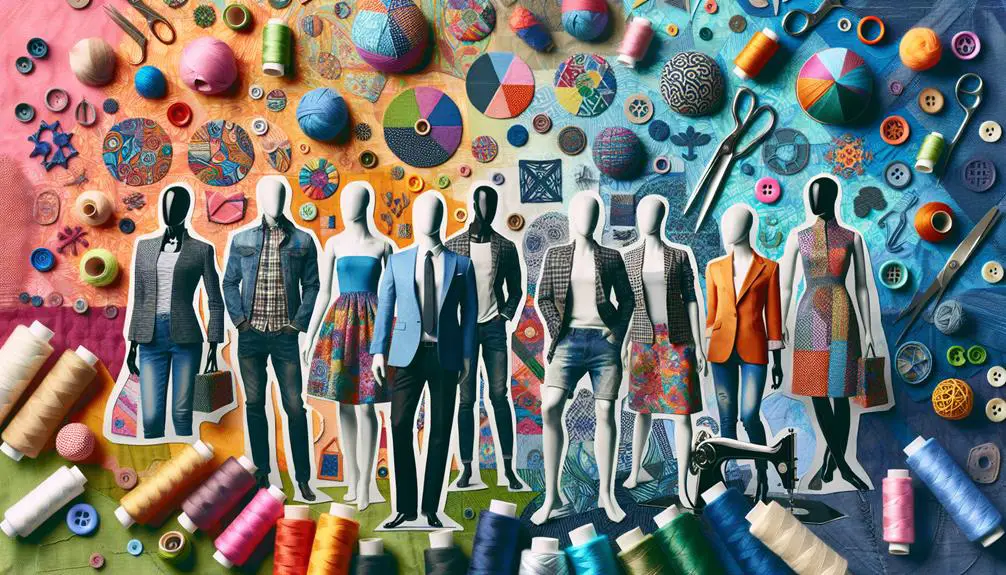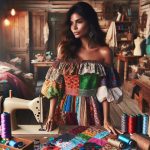Just like Midas turned everything he touched into gold, you can see how upcycled fabrics are transforming waste into fashion. Imagine wearing a jacket made from old denim or a dress crafted from discarded silk scarves. Upcycling not only reduces textile waste but also sparks creativity and innovation within the fashion industry. By breathing new life into old materials, you're supporting a movement that values sustainability and uniqueness. Curious about how this process works or which brands are leading the charge?
Table of Contents
Key Takeaways
- Upcycled fabrics transform waste into stylish, sustainable garments, reducing environmental impact.
- Techniques like patchworking and natural dyeing create unique, eco-friendly fashion from discarded materials.
- Brands like Patagonia and Stella McCartney lead in promoting upcycled fashion and ethical production.
- Upcycled materials, such as denim and vintage silk scarves, offer endless creative possibilities.
- Consumer demand for eco-friendly fashion drives industry innovation and sustainable practices.
History of Upcycled Fabrics
In the early 20th century, resourceful individuals began repurposing old garments out of necessity during times of economic hardship. This innovative practice saw people transforming worn-out clothing into new, functional items, driven by sheer necessity and creativity.
You can trace the origins of upcycled fabrics in art to this era, where the scarcity of resources pushed people to think outside the box. They didn't just mend and repair; they reimagined and reinvented, giving birth to unique pieces that carried their own stories.
Understanding the cultural significance of upcycled fabrics is pivotal. During these times, communities bonded over shared experiences of making do with what they had. By transforming old into new, they preserved not only their garments but also their heritage.
Cultural narratives were woven into the very fabric of these upcycled pieces, making them more than just clothing—they became symbols of resilience and ingenuity.
Benefits of Upcycling
By selecting upcycled fabrics, you're not only reducing waste but also promoting sustainable fashion. This eco-conscious practice minimizes the environmental impact by reusing materials that would otherwise end up in landfills. Each piece created from upcycled fabrics contributes to economic sustainability, as it often involves local artisans and small businesses. By supporting these creators, you help build a more resilient and diverse economy.
One of the greatest advantages of upcycled fashion is the opportunity for creative expression. Using existing materials allows designers to craft unique designs that you won't find in mass-produced clothing. This ensures that your wardrobe reflects your individual style and stands out in a sea of uniformity. Plus, the limited nature of these pieces adds an exclusive edge to your fashion choices.
Moreover, upcycling fosters a culture of mindfulness and intentionality. When you invest in upcycled garments, you're making a statement about your values and commitment to a sustainable future. You're not just buying clothes; you're endorsing a movement towards responsible consumption. Each upcycled item becomes a proof to the possibility of turning waste into something truly beautiful and functional.
Common Upcycled Materials
You can easily transform old jeans into trendy new pieces by using their durable denim.
Vintage silk scarves also offer a unique touch, adding elegance and history to your designs.
These materials not only reduce waste but also give your fashion items a distinctive charm.
Denim From Old Jeans
Transforming worn-out jeans into stylish, sustainable pieces breathes new life into otherwise discarded denim. By embracing innovative designs and sustainable practices, you can turn old jeans into an array of fashionable items. Jeans are a staple in most wardrobes, and their durability makes them perfect for upcycling. You can create everything from chic jackets to trendy handbags, showcasing your commitment to sustainability.
The creative possibilities are endless, and the fashion industry is increasingly recognizing the value of upcycled denim. By reimagining old jeans, you not only reduce textile waste but also contribute to an eco-friendly future. For instance, you can combine different shades of denim to craft unique patchwork jackets or use the fabric to design eye-catching accessories.
Mastering these techniques requires a keen eye for design and a passion for sustainability. You'll find that upcycled denim pieces often carry a story, adding a layer of depth to your creations.
As you explore this avenue, you'll develop a deeper appreciation for the material's versatility and potential. Embrace this opportunity to innovate within the fashion industry and make a meaningful impact on the environment.
Vintage Silk Scarves
Vintage silk scarves provide an opulent and versatile material for creating unique, sustainable fashion pieces. You can transform these elegant textiles into stylish tops, headbands, or even custom linings for jackets. Their vibrant patterns and rich textures bring an element of sophistication to any outfit. When it comes to creative uses, the possibilities are endless. You can sew multiple scarves together to craft a flowing, one-of-a-kind dress or use them as striking accents on handbags.
Incorporating vintage silk scarves into your wardrobe isn't just about creativity; it's also about practicing sustainable fashion. Ethical sourcing is essential here. Make sure you're obtaining these scarves from reputable vintage shops or family heirlooms, ensuring they've a story to tell. By opting for upcycled materials, you're reducing the demand for new fabric production, which often involves harmful environmental practices.
For some styling tips, consider wearing a silk scarf as a belt to add a pop of color to a monochrome outfit. You can also tie one around your neck for a classic, timeless look. Remember, these scarves aren't just accessories; they're statements of your commitment to sustainable practices and ethical sourcing.
Techniques for Upcycling
One effective technique for upcycling fabrics is patchworking, where you sew together small pieces of discarded textiles to create a unique and stylish new material. This method allows for an incredible level of creative stitching, giving you the freedom to experiment with colors, textures, and patterns. By mastering fabric manipulation, you can transform old, seemingly useless scraps into a cohesive and fashionable piece.
Another technique worth exploring is dyeing. Natural dyes from plants and food waste can breathe new life into faded fabrics. Think onion skins for a warm yellow hue or avocado pits for a soft pink. This process is not only eco-friendly but also adds a personal touch to your creations.
Additionally, ponder embellishments like embroidery and beading. These details can elevate a simple upcycled garment to a work of art. They allow for intricate designs and add a layer of complexity to your projects.
Here's a quick comparison of techniques to contemplate:
| Technique | Skills Required | Best For |
|---|---|---|
| Patchworking | Creative stitching | Unique, textured fabrics |
| Dyeing | Fabric manipulation | Color renewal |
| Embellishments | Precision and patience | Detailed, high-fashion items |
| Fabric Weaving | Intermediate crafting | Strong, durable materials |
Leading Upcycled Fashion Brands
After mastering upcycling techniques, it's inspiring to explore leading fashion brands that have turned waste materials into stunning, marketable collections. Brands like Patagonia and Stella McCartney are pioneers in sustainable design. Patagonia's upcycled fashion collaborations with various artists showcase their commitment to ethical production and innovative use of discarded fabrics. Their collections often feature jackets and bags made from recycled polyester and nylon, proving that sustainability and style can coexist.
Another standout is Stella McCartney, who's seamlessly integrated upcycled fabric innovations into her high-end collections. By transforming old garments and textile waste into luxurious pieces, McCartney sets a high bar for ethical production in the fashion industry. Her brand's collaborations with companies like Adidas highlight the potential for blending athletic wear with upcycled materials, pushing the boundaries of sustainable design.
Not far behind are newer brands like Re/Done, which specializes in reworking vintage denim into modern, trendy pieces. Their efforts not only minimize waste but also promote a circular fashion economy. By focusing on quality and innovative use of materials, these leading brands set a powerful example of how upcycled fashion can be both ethical and chic.
DIY Upcycled Fashion Projects
Transforming your old clothes into trendy new pieces can be both a fun and sustainable way to refresh your wardrobe. With a bit of creativity and some basic tools, you can turn your worn-out garments into eye-catching fashion statements.
Here are four inspiring DIY projects to get you started:
- Recycled Jewelry: Take your old t-shirts and cut them into thin strips. Braid or knot these strips to create unique, eco-friendly necklaces, bracelets, or earrings. This not only reduces waste but also adds creative accessories to your collection.
- Denim Tote Bags: Repurpose those old jeans into durable tote bags. Cut out the legs, sew the bottom, and attach a strap. This practical project supports sustainable living by giving your jeans a new life as a stylish, reusable bag.
- Patchwork Clothes: Combine fabrics from different old clothes to create a patchwork jacket or skirt. This method not only salvages fabric but also showcases your personal style and creativity.
- Repurposed Home Decor: Use fabric scraps to make throw pillows, wall hangings, or even rugs. These projects contribute to sustainable living while adding a personalized touch to your home decor.
Upcycled Fabrics in High Fashion
While DIY projects make upcycling accessible at home, the fashion industry is also embracing upcycled fabrics to create high-end, innovative designs. Designers are proving that sustainability and luxury fashion can coexist by transforming discarded materials into stunning, red carpet-worthy creations. Upcycled couture has gained traction, with renowned fashion houses and independent designers alike showcasing their masterpieces on the world's most prestigious runways.
When you think of luxury fashion, it's crucial to recognize how upcycled fabrics are redefining opulence. Designers like Stella McCartney and Marine Serre are at the forefront, combining sustainability with breathtaking elegance. They transform waste into intricate gowns and avant-garde pieces, proving that luxury doesn't have to come at the planet's expense.
Imagine the impact of seeing your favorite celebrities donning upcycled couture on the red carpet. This not only sets a new standard for fashion but also raises awareness about the importance of sustainable practices.
Environmental Impact
Upcycled fabrics reduce waste by repurposing discarded materials into new, stylish garments. By choosing upcycled fashion, you're directly contributing to reducing landfill waste and promoting more sustainable practices.
The environmental impact is profound, and here's how:
- Reducing Landfill Waste: Traditional fashion often discards scraps and unsold items, which end up in landfills. Upcycling turns these materials into valuable resources, decreasing the volume of waste.
- Lowering Carbon Footprint: Manufacturing new textiles demands a lot of energy and resources. Upcycling bypasses this by reusing existing materials, cutting down on the carbon emissions associated with production.
- Conserving Water: Textile production, especially cotton, requires vast amounts of water. Upcycled fabrics eliminate the need for new raw materials, thereby saving precious water resources.
- Encouraging Sustainable Practices: By supporting upcycled fashion, you're fostering an industry shift towards more sustainable practices. This not only benefits the environment but also sets a standard for future innovations in fashion.
Consumer Influence
Choosing upcycled fashion empowers you to drive demand for sustainable practices in the industry. Your consumer behavior influences brands to adopt more ethical fashion standards and embrace eco-friendly trends. By making sustainable choices, you're not just buying clothing; you're casting a vote for the kind of world you want to live in.
When retailers notice the growing interest in upcycled fabrics, they're compelled to innovate and prioritize sustainability. Here's a quick overview of how your choices impact the fashion ecosystem:
| Consumer Action | Brand Response | Industry Impact |
|---|---|---|
| Buying upcycled clothing | Increased eco-friendly product lines | Reduction in textile waste |
| Supporting ethical brands | Adoption of ethical fashion practices | Improved working conditions |
| Advocating for sustainability | Greater transparency in sourcing | Enhanced brand accountability |
| Prioritizing quality over quantity | Focus on durable, timeless pieces | Shift towards slow fashion |
The Future of Upcycled Fashion
As consumer demand for upcycled fabrics grows, the fashion industry's future looks increasingly sustainable and innovative. You're witnessing a pivotal shift towards sustainable design and ethical production, driven by a circular economy that values resource efficiency and waste reduction. Upcycled fashion is no longer a niche market; it's rapidly becoming mainstream, thanks to advancements in innovative textiles.
Here are four trends that will shape the future of upcycled fashion:
- Enhanced Material Recycling:
Expect to see more sophisticated recycling methods that turn post-consumer waste into high-quality fabrics, pushing the boundaries of what's possible with upcycled materials.
- Tech-Driven Solutions:
Technologies like blockchain for supply chain transparency and AI for design optimization will revolutionize how upcycled fabrics are sourced and produced, ensuring ethical production practices.
- Collaborative Platforms:
Brands and designers will increasingly collaborate with recycling companies and tech firms, fostering a more integrated approach to sustainable fashion.
- Consumer Empowerment:
You'll have more tools and platforms to make informed choices, from apps that track the sustainability of your wardrobe to marketplaces exclusively featuring upcycled products.
Frequently Asked Questions
How Do I Care for Garments Made From Upcycled Fabrics?
To care for garments made from upcycled fabrics, follow these washing tips: use cold water and gentle cycles. For storage methods, keep them in a cool, dry place. Master repair techniques and stain removal to extend their lifespan.
Are Upcycled Fabrics as Durable as New Materials?
You might wonder if upcycled fabrics are as durable as new materials. Durability comparison shows they can be just as strong, while their positive environmental impact makes them a smart choice for eco-conscious consumers like you.
Can Upcycled Fashion Be Tailored to Fit?
Yes, you can have upcycled fashion tailored to fit perfectly. Custom alterations allow you to enjoy tailored designs that promote sustainable fashion, ensuring your eco-friendly style doesn't compromise on fit or aesthetic appeal.
What Are the Costs Associated With Upcycled Clothing?
While upcycled clothing can save the planet, it might cost more due to the labor-intensive process. However, the environmental impact is minimal, and market demand for sustainable fashion justifies the investment.
How Can I Identify Clothing Made From Upcycled Fabrics?
To identify clothing made from upcycled fabrics, check for labels indicating sustainable sourcing and material transparency. Brands often promote their eco-friendly practices, so look for certifications or detailed information about the fabric's origin and production process.
- Tetron Fabric for Marine Applications: Durability and Use Cases - June 18, 2025
- Tetron Fabric for Outdoor Furniture: Weather Resistance and Care - June 18, 2025
- Tetron Fabric for Wall Coverings: Style and Application Tips - June 18, 2025







